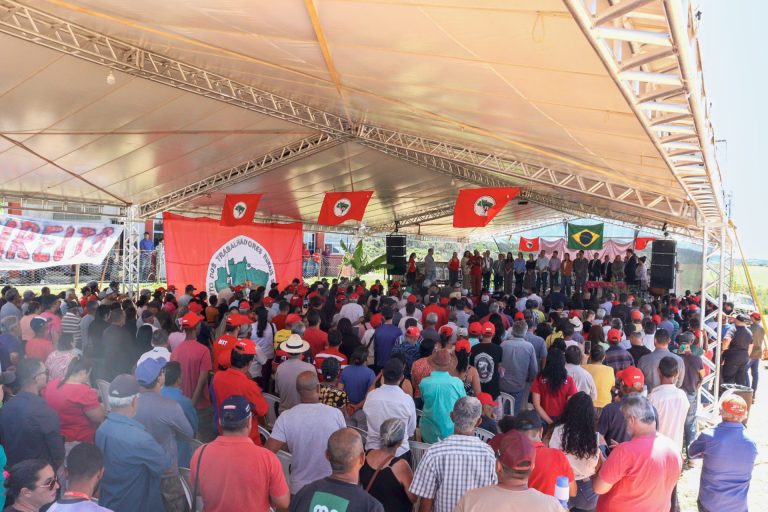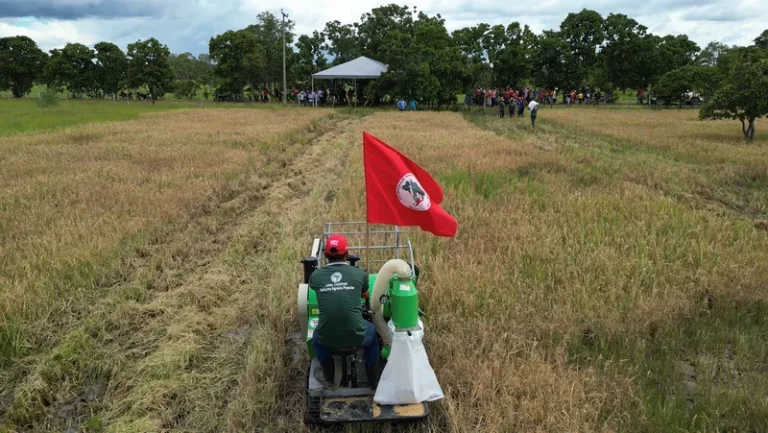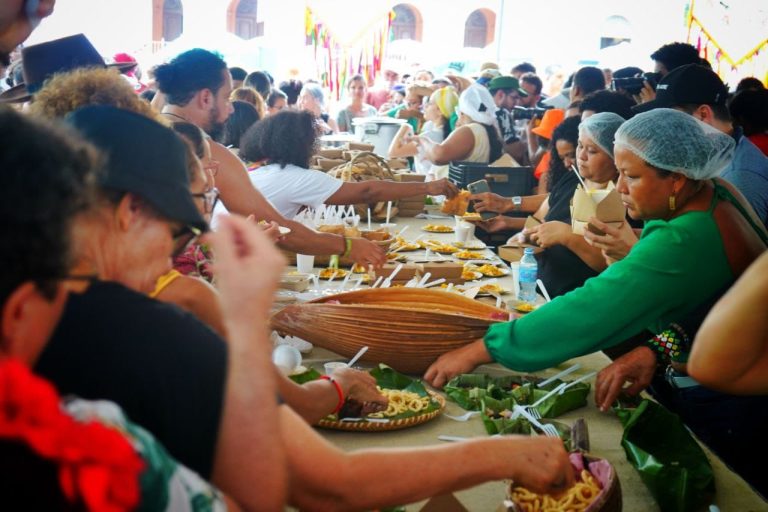The Political Organisation of Brazil’s Landless Workers’ Movement (MST)
This dossier focuses on the MST’s tactics and forms of organisation and why it is the only peasant social movement in Brazil’s history that has managed to survive for over a decade in the face of the political, economic, and military power of Brazil’s large landowners
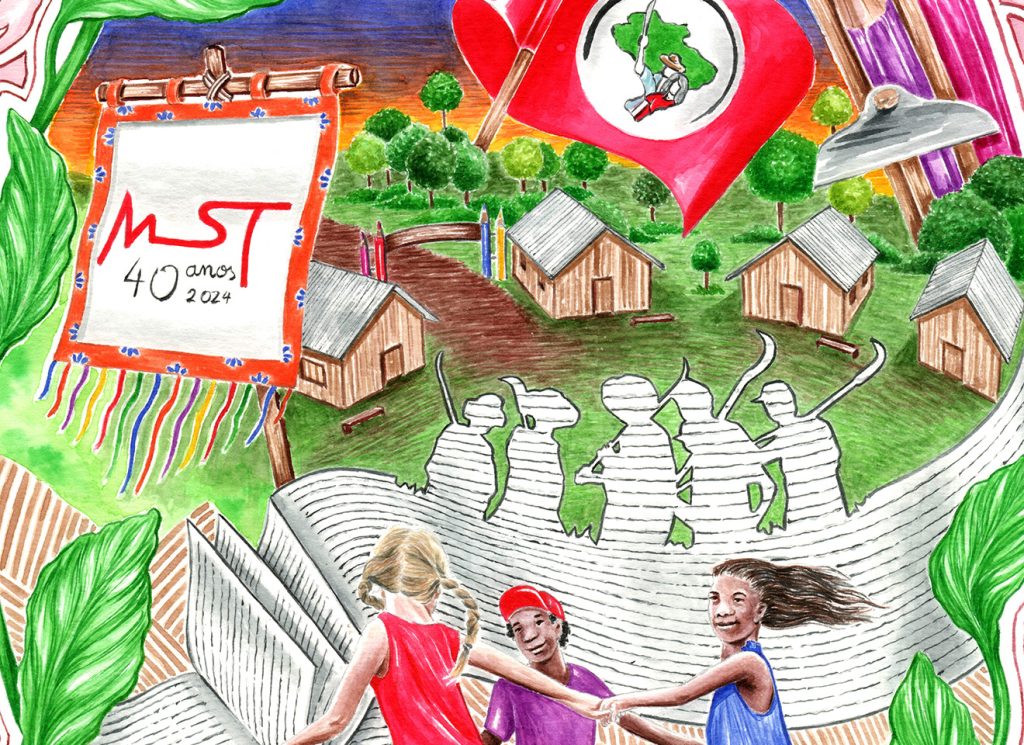
By Tricontinental – Dossier nº 75
The artwork in this dossier was created for the ‘Forty Years of the MST’ call for art organised by the Landless Workers’ Movement (MST), Tricontinental: Institute for Social Research, ALBA Movements, and the International Peoples’ Assembly.
We are immensely grateful to the more than 150 artists whose contribution and solidarity in this process further enrich and beautify the struggle of the working class, especially the peasant struggle, in addition to offering reflections on the challenges that lie ahead.
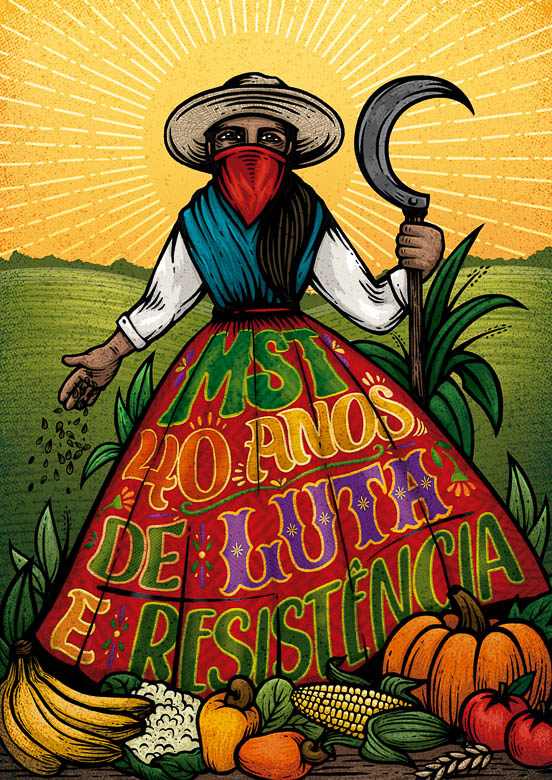
Introduction
In September 1982, thirty rural workers and twenty-two clergy members took part in a meeting in Goiânia, in Brazil’s Central-West region, convened by the Pastoral Land Commission (CPT, a branch of the Catholic Church inspired by liberation theology). This small group of workers would go on to lead the first peasant protests to take place after eighteen years of repression at the hands of the business-military dictatorship that governed Brazil for twenty-one years (1964–1985).
The mood was hopeful. The dictatorship was languishing due to its economic failures and the resumption of mass struggles in Brazil, primarily led by a labour movement that would go on to produce new leaders and give rise to the foundation of the Workers’ Party (PT) in 1980 and the Unified Workers’ Central of Brazil (CUT) in 1983, a powerful trade union federation without parallel in the country’s history. Similar dynamics were underway throughout Latin America and the Caribbean as the liberation struggles in Nicaragua and El Salvador brought other US-aligned military dictatorships to their knees, sending waves of inspiration across the continent just as the Cuban Revolution had done years before.
Peasant protests, still a disparate force spread across Brazil’s vast landscape, faced political repression as well as the forced modernisation of agriculture through mechanisation, the intensive use of pesticides, and subsidies for large rural properties, triggering a rural exodus. Despite this, the peasants began to occupy large estates in several states from 1979 onwards, in many instances with the support and participation of the CPT. Participants of the Goiânia meeting discussed what might come from these actions and issued a statement underscoring the need for a national, autonomous peasant movement that would fight for agrarian reform. The meeting bore fruit two years later, in 1984, when Brazil’s Landless Workers’ Movement (MST) was founded at a meeting in Cascavel, Paraná attended by ninety-two peasant leaders.
By 1996, the MST was operating in every region in Brazil and had won land for thousands of families, with its agrarian reform settlements receiving support and solidarity from a number of Brazilian and international left-wing organisations and individuals. However, the MST was not yet seen as a relevant political actor in the country, as it was unknown to most of Brazil’s urban population. This would soon change. That year, thousands of peasants marched on Belém, the capital of the Amazonian state Pará, to demand a public hearing with the governor. At the head of the march was nineteen-year-old Oziel Alves, who was tasked with keeping morale high among his comrades with slogans and words of encouragement.
In Eldorado do Carajás (in southern Pará), the peasants were surrounded by police and gunmen who had been hired by powerful companies in the region. The police identified Oziel as a leader, separated him from the group, and – at gunpoint – ordered him to kneel and repeat the words he had said into his microphone minutes earlier. Without missing a beat, Oziel yelled his last words: ‘long live the MST!’.
Oziel was one of nineteen activists killed in what became known as the Eldorado dos Carajás Massacre.
The days following the massacre were recorded by the internationally renowned photographer Sebastião Salgado. These photographs, accompanied by the music of singer-songwriter Chico Buarque de Hollanda and the prose of Portuguese writer José Saramago, travelled across the globe in an exhibition entitled Terra (‘Land’).
However, it was not this tragedy that transformed the MST into a recognised political force, but rather the way the movement responded to the repression. In February of the following year, in the face of police impunity and the paralysis of agrarian reform, 1,300 MST activists began a long march from three starting points across the country that was set to arrive in the capital, Brasília, on 17 April 1997, exactly one year after the Eldorado do Carajás Massacre. At the time, the minister of agrarian development agreed to meet with the marchers only because he was convinced that they would never complete the roughly 1,000 km journey to Brasília. Nevertheless, the three MST columns entered the capital, on schedule, with 100,000 supporters – the most significant political action against the neoliberal government of then President Fernando Henrique Cardoso. This demonstration of strength and organisation transformed the MST into a major player in Brazilian politics – a position it holds to this day.1
Eight years later, under the presidency of Luíz Inácio Lula da Silva (an old ally and supporter of the struggle for agrarian reform), the MST organised a national march to raise the government’s awareness of the impact of the financialisation of agriculture and to demand a new national plan for agrarian reform.2 From 2 to 17 May 2005, 15,000 landless workers pitched tents along their route every day, creating what was effectively a small, moving city with infrastructure such as bathrooms, kitchens that provided food for all of the marchers, and facilities that allowed the children who were accompanying their parents to keep up their studies at the end of each day. To ensure organisation in the ranks, a portable radio transmitter sent messages to 15,000 radios carried by the peasants. After the march, the Brazilian army invited an MST leader to deliver a lecture at the War College (Escola Superior de Guerra) to learn how a grassroots movement had achieved such a high level of organisation.3
In the four decades since its founding, the MST has achieved significant milestones: for one, 450,000 families have gained legal tenure of their land, which has been transformed into agrarian reform settlements. The residents of the settlements have formed 1,900 peasant associations as well as 185 cooperatives, ranging from local agricultural production cooperatives to marketing and service provision cooperatives that operate on a regional level. Part of what is produced in the settlements is processed in 120 MST-owned agro-industrial sites. In addition to the settlements (assentamentos), which have gained legal ownership of the land, there are another 65,000 organised families living in squatters’ encampments (acampamentos) fighting for legal recognition of land.4
There are several reasons why the MST is the only peasant social movement in Brazil’s history that has managed to survive for over a decade in the face of the political, economic, and military power of Brazil’s large landowners. One of the main explanations for how the movement has managed to resist and keep growing in spite of such an unequal correlation of forces is the strength it draws from its mass base and its organisational methods. Another reason for the MST’s resilience is solidarity, both within the country and internationally. Though there are many aspects of the MST’s struggle that merit further discussion (such as the movement’s pedagogical approach,5 political education, women’s organising, agroecological production, and organisation of cooperatives), this dossier focuses on the MST’s tactics. It is hoped that this experience – described in the context of Brazil and without trying to offer set formulas – can contribute to the reflections and organisational efforts of other popular and peasant movements around the world.
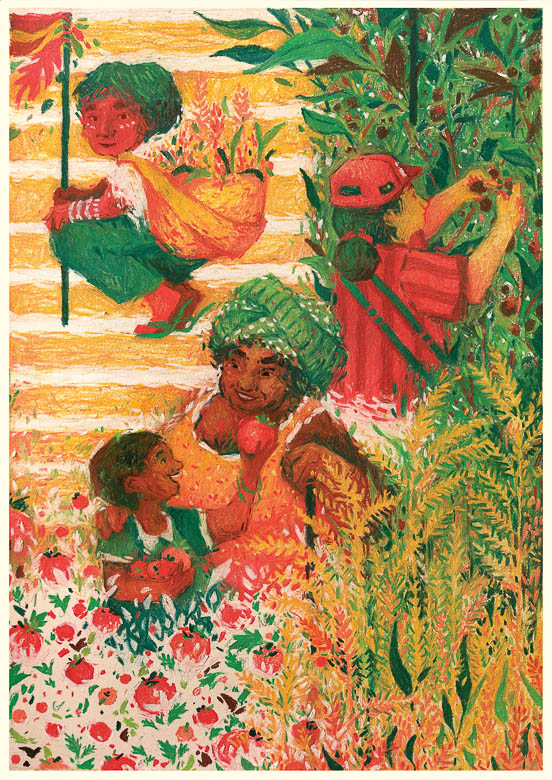
The Agrarian Question in Brazil
From the sixteenth century onwards, what is now Brazil was founded and organised as an export colony based on large-scale land ownership, slave labour, and export-oriented monoculture production. Through gunpowder and the cross, the Portuguese colonial enterprise created a violent rupture with indigenous societies’ way of life, introducing a concept that was alien to them: private ownership of nature’s common goods.6
In 1850, faced with the imminent end of slavery due to abolitionist movements and uprisings by enslaved peoples, the Brazilian Empire instituted the country’s first land law to prevent freed slaves from accessing the country’s greatest source of wealth: land. Through this law, land became a commodity. Furthermore, the plantation model, centred on large estates that relied on export-oriented monoculture and the super-exploitation of labour, would become the only constant in Brazilian history, regardless of whether Brazil was a Portuguese colony or an independent nation, whether it was a monarchy or a republic, and whether it was characterised by a parliamentary or a presidential system of government.
The agrarian question has been a central theme in Brazil’s history and the reason for many uprisings, revolts, and popular movements, from indigenous resistance and uprisings against slavery to the establishment of quilombo7 communities and the first peasant and labour movements. The role of the state in defending the interests of landowners and repressing the poor is particularly noteworthy. While indigenous and enslaved populations were primarily persecuted and attacked by private militias, the army of the newly declared republic was used to crush the movements in Canudos (1897), a self-managed community of 25,000 peasants; Contestado (1916), an armed revolt by farmers who sought to prevent their lands from being taken over by an American railway company; and other organisations such as the Peasant Leagues, which fought for agrarian reform before the business-military coup d’état of 1964. As a consequence of centuries of repression, twenty-first century Brazil remains the country with the second-highest level of land concentration on the planet, a title it has held throughout the last century, with 42.5% of land controlled by less than 1% of the population.8 Meanwhile, there are 4.5 million landless peasants.9
Though the class enemies of landless rural workers are the large landowners and transnational companies that appropriate land to produce commodities, part of the pressure generated by people’s movements must also be directed towards the state. This is necessary, in part, because of the nature of the Brazilian Constitution, which was approved in 1988 after the fall of the dictatorship and has many progressive components – including some related to agrarian reform – since it was drafted amidst the rise of mass popular struggles. For instance, Article 184 requires rural property to fulfil a social function, be productive, and respect labour and environmental rights. The state has the right to expropriate landholdings that do not meet these criteria, though it must compensate the owner before transferring the deed to public ownership or granting land rights to the landless families who settle there.
Nonetheless, over the last few decades, large, landed estates have shifted to a model known as agribusiness, leading Brazil to become the largest consumer of pesticides in the world, with a record consumption of 130,000 tonnes in 2023.10 International financial capital, which now controls the entire rural production chain, from seeds to the sale of agro-industrial products, has made substantial investments in large, unproductive estates that are used for speculation. In 2016, twenty foreign corporations controlled 2.7 million hectares of Brazilian agricultural land.11 This land is used for export-oriented monoculture, now converted into commodities (primary products traded on a large scale according to global standards) as financial and speculative assets and traded on stock and commodities exchanges. In 2021, a mere five commodities – soy, corn, cotton, sugar cane, and cattle – accounted for 86% of Brazil’s agricultural land as well as 94% of the volume of production and 86% of its value.12
This economic power is also manifest in political power, as evidenced by the fact that people who represent agribusiness interests have held ministerial positions in every single administration over the last three decades. The Ruralista Caucus, a multipartisan organisation of elected representatives dedicated to defending the interests of agribusiness, brings together 324 members, or 61%, of Congress and 50 members, or 35%, of the Senate.13 This has given the group enough power to pass environmental and land deregulation laws and to submit the MST to four investigations through the Parliamentary Commission of Inquiry (CPI) over the last two decades. No other grassroots organisation in Brazil’s history has been the object of so many attempts at criminalisation by parliament.
The first CPI took place in 2003 and sought to force then President Lula’s administration to distance itself from the MST as well as to prevent public funds from being allocated to agrarian reform and to criminalise the struggle for land. The 2023 CPI investigation, led by members of the most radical core of former President Jair Bolsonaro’s coalition, had similar goals to pressure the new Lula administration, which brought the Workers’ Party back to power following a judicial coup and the 580-day imprisonment of then-candidate Lula. However, it backfired. By the time the 2023 investigation took place, the MST’s public image had been strengthened as a result of the solidarity activities it carried out during the COVID-19 pandemic. This in turn increased solidarity with the MST and thereby deprived the commission of political or media support, leaving it unable to even approve a final report.
This is no small feat, given the hegemony of agribusiness in Brazilian society, which is built upon not only a sophisticated and powerful cultural industry, from television to music, but also archaic methods of violence and repression. This is evidenced by the CPT’s 2022 survey, which recorded 2,018 incidents of social conflicts in the countryside – a 33.6% rise from the average figure in 2016 – and 47 murders linked to land or environmental issues.14
But, despite its deep entrenchment in Brazilian, society, economics, and politics, agribusiness is not the only agricultural model, nor is it one that responds to the needs of the majority or the planet. During its Third National Congress in 1995, the MST presented and ratified its agrarian reform programme for the first time, based on an analysis of the class struggle in the Brazilian countryside and a set of proposals to transform the structure of Brazilian land ownership and the conditions of rural life. In 2015, the programme was updated with an important theoretical and structural change: while political parties and universities misunderstood the nature of and even welcomed agribusiness in Brazil, the MST built a collective definition of the term as ‘the presence of transnational financial capital in the countryside for the production of commodities’.15 Furthermore, the MST warned that the mere existence of agribusiness and its links with the state prevented any classical type of agrarian reform within a capitalist framework, in which land is simply redistributed or its access is democratised, from moving forward.
In this context, the MST redefined its tactics and its agrarian programme by creating a new concept: popular agrarian reform. In addition to demanding that land be distributed to peasants, popular agrarian reform discusses the need to produce healthy food for the entire population alongside changing the current production process, which is based on the agribusiness model, to one based on agroecology, which preserves nature’s common goods. This shift also helped build a greater alliance with urban workers, who are the biggest beneficiaries of access to affordable, healthy food. Popular agrarian reform not only seeks to further the interests of the peasantry, but those of society as a whole. This is reflected, for instance, in its understanding of food sovereignty, in its potential to generate alternative forms of employment and income, and its commitment to fighting the environmental catastrophe.
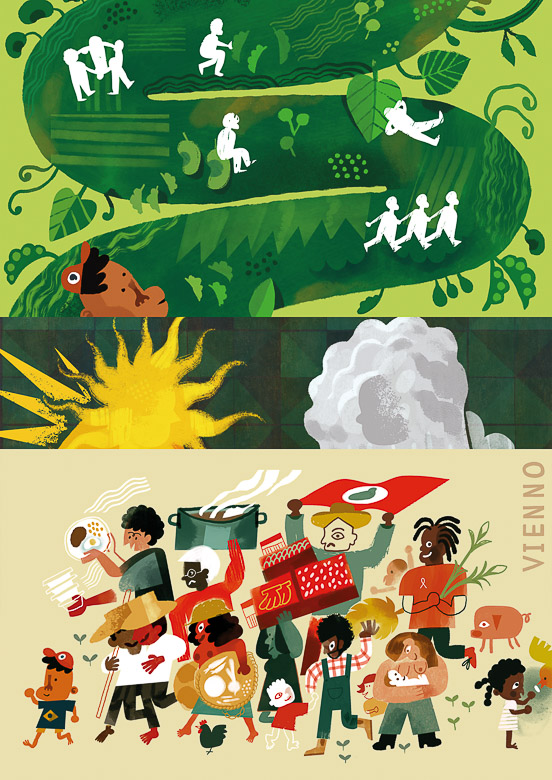
Forms of Struggle and Consciousness-Raising
The MST has three goals: 1) to fight for land (that is, for families who are part of the movement to gain enough land to survive through their own labour with dignity); 2) to fight for agrarian reform, which means restructuring land ownership and use; and 3) to transform society. To achieve these goals, the MST has, from the beginning, defined itself as ‘a mass movement that is popular, union-like, and political in nature’.16 It is a mass movement because it understands that the correlation of forces can only be changed in its favour by a large number of organised people. It is a popular movement because it is open to the participation of all people who wish to fight for the right to work the land. It is structured like a union because the struggle for agrarian reform has an economic dimension that involves real and immediate gains, and it is political because it knows that agrarian reform can only be achieved through the structural transformation of society.
The MST is a national movement that operates in twenty-four of Brazil’s twenty-six states. This differentiates it from the movements that preceded it, which were local and regional in scale, enabling them to be isolated by repressive forces. The MST’s presence across most of Brazil enables it to support individual state chapters that are facing challenges and amplify local struggles on a national level.
The strength of the MST, therefore, lies in the size and organisation of its base. Even though the MST has many forms of organisation, which vary according to each context and place, the fundamental feature of its organisational methodology is to put people in motion and in struggle. They then develop their political and social consciousness through their struggle.
The first way in which the MST engages in struggle is through land occupations. Before or during the period when the land is first occupied, the MST organises encampments for landless families. These families are organised through grassroots outreach, first by identifying areas where peasants are concentrated and then by holding meetings. The families then participate in organising and preparing what is needed for the encampment, looking for ways to obtain tarps for their shelters, transportation for families to the locations to be occupied, and so on. These encampments play the role that factories played in building workers’ struggles in the nineteenth and twentieth centuries. Bringing peasants together in the same place and overcoming geographic isolation fosters cooperation and sociability.
When families join an encampment, they are organised into base groups17 of ten to twenty people. This number is small so that members can get to know each other and avoid being infiltrated by strangers. Furthermore, by being divided into small groups, more people have an opportunity to participate in discussions and voice their opinions on the encampment’s political organisation. Everyone has the right to speak in these groups, including children. In the encampments, tasks are organised collectively, such as collecting water and firewood, securing food donations, setting up shelters, providing security, and educating the children. These tasks are allocated to teams called setores (‘sectors’), which are made up of members of the base groups in such a way that every base group has at least one participant in every sector. In this way, everyone participates in debates and political and organisational life, and the tasks in the encampment are carried out collectively. Regardless of the number of people involved, base group and sector meetings are always scheduled in advance, with a well-defined agenda for discussion, and are always coordinated by a man and a woman. One of the group members is tasked with taking notes at the meeting so that they can be ratified by the group as a whole.
When it comes to decisions that affect the whole encampment, base groups discuss the issues at hand and then their coordinators meet, each bringing their group’s opinions. If there is no consensus, they return to their groups with new questions, seeking to synthesise the discussion and reach collective decisions.
In these encampments and land occupations, assemblies are frequently used as a means to arrive at collective decisions on issues, such as whether to occupy a large estate or whether to retreat in a conflict. But assemblies are only efficient when all participants understand all aspects of what is being discussed and the discussions are restricted to a few options, such as whether or not to occupy land and whether or not to resist a forced eviction. Therefore, they are neither the main nor the most common form of participation in the movement.
Once the land is legally acquired, it becomes an agrarian reform settlement and families remain organised in the movement. One of the first challenges the movement faces as encampments become settlements is how to keep families organised once they acquire legal rights to the land. Part of the sociability and cooperation that exists in the encampment is lost in this transition. So, the MST has developed some strategies to keep the assentados (residents of the agrarian reform settlements) in motion.
The years of living and struggling in encampments before being granted legal rights to the land forges an identity through shared struggle, leading members of the settlements to identify with families who are still in encampments. This collective struggle also instils values like internationalism and solidarity. Workers organised by the MST identify themselves as Landless (Sem Terra, with capital letters). This identity remains even after they are granted legal rights to the land.
When the Sem Terra win their legal right to the land and begin to set up the agrarian reform settlement, new demands and struggles arise such as access to rural credit, education, health, culture, and communication structures both within the settlements and encampments and with the society at large. In order to meet the new needs that arise, the MST relies on the same organisational structure that it established as the encampment fought for legal recognition. All families in the agrarian reform settlement are organised into neighbourhood base groups, which are also coordinated by a man and a woman who call meetings, keep track of decisions that are made, and communicate with the settlement’s leadership. Each organisational level within the MST, from encampments to settlements, from states to regions and nationwide, is collectively and democratically managed.
In order to prevent centralism and personalism, the MST does not and has never had a single ‘president’ or ‘director’ who is responsible for making political decisions or who is differentiated from the other activists. All leadership positions of decision-making bodies in the movement, from the base groups to the national directorate, are collective and carry renewable two-year mandates. The division of labour is based on this principle: everyone must have, to a greater or lesser extent, responsibilities within the organisation so that there is no excessive centralisation and so that no activist is overwhelmed with work.
Towards this end, the daily tasks in the encampments and settlements are distributed among teams that respond to needs as they arise, such as organising education, health, and financial issues. As situations become more complex and more organisation is needed, more teams are formed. They are organised into sectors at the state and national level to plan and carry out specialised tasks, such as production; the mass front, which coordinates protests and occupations; education; and training. For example, an education sector is made up of all educators or those involved in education within a defined area of municipalities in a region, and it develops pedagogical proposals and works in the schools in this area on a day-to-day basis. In the production sector, activists organise the local economy and cooperatives, as well as the agroecological technology used for cultivation. Within the sectors, the various aspects of the Sem Terra’s identity, beyond their identity as members of the encampments or settlements, are recognised and given representation, whether as youth, members of the LGBTQ+ community, or otherwise. Activities and meetings held with the ‘Little Landless’ children (Sem Terrinhas) in agrarian reform settlements and encampments are another way of ensuring the full participation of all of the MST’s base, no matter their age, identity, or otherwise. In July 2018, the first National Meeting of Sem Terrinhas in Brasília convened over a thousand children, setting up a temporary encampment for the event where children – who led the activities, assisted by adults – studied, played games, and learned about the struggle for land.
It is essential to bring people together, create spaces for collective discussion, and set them in motion through struggle and cooperation. This means that, even though the MST is best known for land occupations, the movement employs different tactics according to its needs and conditions. Among them are marches (some of them national, as in 1997 and 2005), occupations of public buildings, road blockades, and hunger strikes.
It is concrete actions and struggle that prevent activists’ political consciousness from going dormant in the encampments and settlements. For instance, solidarity is not merely rhetorical or theoretical – it is one of the MST’s main human and socialist values. This is evidenced by the fact that the MST donated over 1,000 tonnes of food across Brazil during the COVID-19 pandemic, which it organised through its solidarity kitchens, gardens, and communities. From October to December 2023 alone, the MST sent 13 tonnes of food as part of an ongoing effort to provide aid to the victims of Israel’s attacks on the Gaza Strip.18 Through such actions, the MST holds conversations with families on the settlements and encampments to discuss not only the act of solidarity itself but also the production and logistical planning that it requires. During this process, families are able to develop practical knowledge of realities different from their own, especially urban environments.
Another important way that the MST shapes their activists’ political consciousness is by organising cooperatives. This process is not only cooperative in terms of its labour structure, but also in terms of how the surplus produced by the cooperatives is distributed and how the land itself is organised. For instance, agrovilas (agrovillages) are established within the settlements, bringing individual households and their plots together into housing clusters that coordinate their harvests collectively and socialise domestic work with collectively run kitchens and children’s circles that provide childcare.
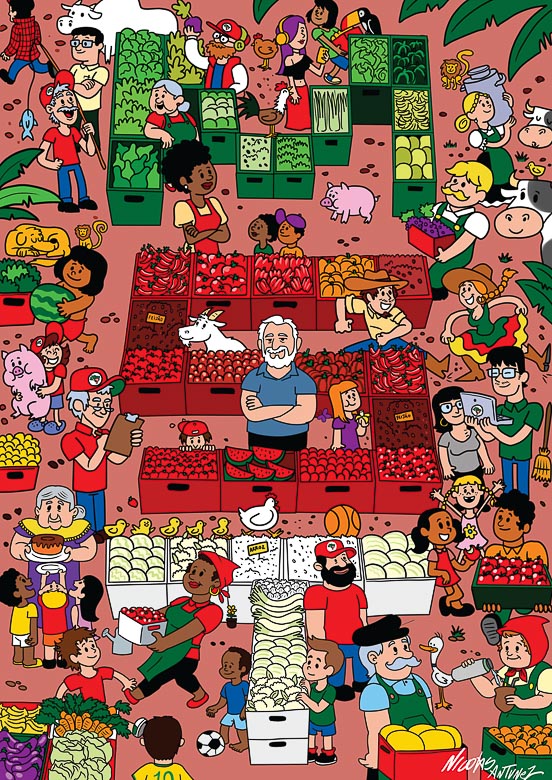
The MST’s Organisational Principles
As a national mass movement, the MST embraces the autonomy of its state, regional, and local groups. In this way, each group of organised families, whether in a settlement or encampment, has the authority to make decisions regarding their reality. For this mechanism to function in an autonomous manner with organisational consistency, unity is essential. This unity is possible because of the characteristics that have defined the MST since it was founded in 1984.
The identity and unity of the MST, and any organisation, are defined by its values, form of organisation, and goals. Suppressing any of these principles would distort the organisation and alter its nature. These characteristics have remained unchanged in essence for the last four decades since the MST’s founding, but they have become deepened and expanded upon at times to increase participation and raise consciousness levels in the mass movement.
One of these principles is autonomy in relation to political parties, churches, governments, and other institutions. The MST is autonomous in relation to other organisations so that it can define its own political agenda. This means that while the MST works with other political parties and religious organisations, this relationship is fraternal, not subordinate. Thus, the MST can build its own reading of reality and the struggle for land, and it can establish tactics based on its own perceptions along with the demands of the organised families.
As mentioned earlier, participation is necessary for the movement to be popular and of the masses. The following is an example of how this principle can be expanded and deepened while preserving its essence. Initially, men occupied most of the MST’s coordinating positions. Women’s organising, which was part of the MST’s struggle from the beginning, grew in several ways over the years, primarily through the Women’s Collective. The collective organised political education for encampments, direct actions against transnational corporations, and study spaces on gender relations and capitalism, among other activities. As a result of the collective’s work, the movement created a new standard in the late 1990s that every leadership position must be occupied by a man and a woman. This doubled the number of participants and began to accurately represent the weight that women held in the organisation. This mechanism reinforced another principle: collective leadership.
Discipline is fundamental for the principles of participation and collective leadership to work. For the MST, discipline means respecting collective decisions and political positions and complying with them. Decisions are rarely made by vote in the MST. Most decisions are made by consensus. When there is a problem building consensus on an issue, the debate returns to the base groups and coordinating bodies until the decisions have gained acceptance and then, once next steps have been decided upon, all members of the movement follow and implement it. Discipline refers to this compliance with collective decisions.
A common characteristic of social movements is that they build strategies and tactics based on their own practices. Without action and practice, there can be no popular movement. However, for an ongoing interpretation of reality, practice alone is insufficient. For this reason, another organisational principle valued in the MST is study. The movement has organised families to fight for schools in settlements and encampments, successfully pressuring local authorities to build more than 2,000 public schools in agrarian reform settlements. Furthermore, 50,000 people have learned to read and write through its literacy programmes for youth and adults, whether stand-alone or in partnership with local governments.19 Another aspect of study is political education, which is conducted through different processes such as publishing books and pamphlets, creating grassroots study groups, and organising courses, which have come together in the Florestan Fernandes National School (Escola Nacional Florestan Fernandes or ENFF). The ENFF is the MST’s national political education school and is a member of the coalition of political education schools of the International Peoples’ Assembly, a global process of peoples’ organisations, social movements, political parties, and unions.
The ENFF was inaugurated on 23 January 2005 and named in honour of the Brazilian Marxist activist, sociologist, and politician Florestan Fernandes, who was a founder of the Workers’ Party and a federal deputy involved in drafting the Brazilian Constitution after the end of the business-military dictatorship. Since then, the school has become an international reference point for uniting practice with political theory. Throughout the year, activists, leaders, and cadres from peoples’ organisations that fight for social change across the world study a broad range of topics, such as the classics of Brazilian and international political theory. Courses last from one week to three months and are taught by volunteer teachers and intellectuals.20 The ENFF also offers training focusing on various topics, such as the agrarian question, Marxism, feminism, and diversity. With teachers and students coming from a broad range of countries, most of them from across Latin America, the ENFF fosters cultural and political exchanges between popular movements and provides political education on the global economic and social panorama, always from a working-class perspective.21 The school was built by landless workers from across Brazil who organised themselves into volunteer work brigades. The construction materials were gathered through international solidarity committees, and the intellectual property rights from the Terra exhibition made up of the work of Sebastião Salgado, Chico Buarque, and José Saramago were donated to generate funds.
In addition to the ENFF, the movement has organised other schools, such as the Josué de Castro Education Institute, which specialises in training young managers for cooperatives, and agroecology schools such as the Latin American School of Agroecology (ELAA) and the Educar Institute in southern Brazil; the Egídio Brunetto Popular School of Agroecology and Agroforestry (EPAAEB) in north-eastern Brazil; and the Latin American Agroecology Institute (IALA) in the Amazon region.
Part of the efforts to democratise access to learning materialised with the National Education Programme for Agrarian Reform (PRONERA), a public policy that was implemented as a result of the national march to Brasília in 1997. Through PRONERA, the Brazilian government encourages the creation of educational programmes, including undergraduate and postgraduate programmes for landless workers. Through this programme, over 100 agreements have been made with public universities that have enabled access to agricultural engineering, veterinary, and nursing degree programmes, as well as teacher training courses, among many others. In this way, the MST has occupied a traditionally elitist and inaccessible space and forced the academic world to open its doors to the experience and knowledge produced in the heat of the struggle.
Another key principle within the MST is internationalism, both as a value and political strategy. As a world system, capitalism treats the entire globe as a battlefield. For this reason, resistance must also be global. In addition to its relationships with peasant movements such as La Vía Campesina and the Latin American Coordination of Rural Organisations (CLOC), the MST participates in broader spaces such as ALBA Movements and the International Peoples’ Assembly.
However, internationalism is not limited to spaces for international encounters and meetings: it must also materialise through action. This takes place in various ways, from the simplest acts of solidarity with families on encampments and settlements to creating internationalist brigades formed by members of the MST to work on exchange visits in the fields of agroecology, production, education, and political education. Since their start in 2006, the MST’s internationalist brigades are currently operating or have operated in Venezuela, Haiti, Cuba, Honduras, El Salvador, Bolivia, Paraguay, Guatemala, East Timor, China, Mozambique, South Africa, and Zambia.
The longest standing of them, the Apolônio de Carvalho Brigade, whose name pays homage to a Brazilian communist activist who fought in the Spanish Civil War and the French Resistance, operates in Venezuela, where it provides political education and promotes agroecological techniques. The Jean-Jacques Dessalines Brigade in Haiti has been operating in a similar manner since 2009, the year before an earthquake ravaged the country. In Zambia, the Samora Machel Brigade works to further literacy and promote agroecology among peasants. In Palestine, every two years the Ghassan Kanafani Brigade collaborates in harvesting olives in territories threatened by Israeli settlers.
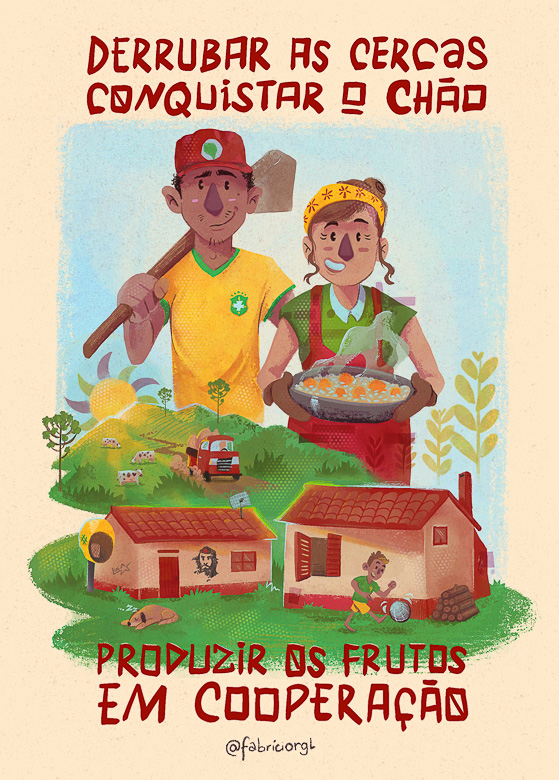
The Future of the Struggle for Land in Brazil
The MST’s current agrarian reform programme is shaped by the contradictions and demands of the struggle in the countryside, which establish the direction that the struggle for land should take not only in Brazil but across the Global South. In this section, we will highlight some of the characteristics of this struggle and the challenges it faces.
The struggle for land is increasingly international. Financial capital has concentrated income and land into very few hands across the planet and has reduced control of the entire agricultural production chain to just 87 corporations based in 30 countries.22 These transnational corporations threaten biodiversity and local culture with their demands to standardise food, set prices globally, and interfere with national legislation and rights. This means that peasant resistance must also be increasingly international and use joint platforms and actions to pressure multilateral organisations. Above all, these transnational corporations must be fought everywhere.
The struggle for land is a struggle over technology. The widespread use of Genetically Modified Organisms (GMOs) and the intensive use of pesticides are inherent to agribusiness. Without this technological package, it is impossible to produce monoculture on a global scale. To speak of ‘green’ or ‘sustainable’ agribusiness is nothing more than advertising. To overcome this model, agroecology must be strengthened and adopted on a massive scale, such as by regenerating soil and biodiversity, adopting and disseminating new production and environmental preservation techniques and technologies, and manufacturing machinery, equipment, and tools suited to the needs of peasants.
Agriculture is not the only sector plagued by big tech: the centralisation and concentration that are characteristic of financial capital have brought technology companies, financial technology firms, and agribusiness companies closer together, as we described in our dossier no. 46, Big Tech and the Current Challenges Facing the Class Struggle. This tendency sets the technological standard for machinery by appropriating vast amounts of data from nature, which is then ‘imprisoned’ in the cloud infrastructure controlled by the Global North.23
The struggle for land is a struggle for food. The COVID-19 pandemic demonstrated how transnational corporations took advantage of the global crisis to inflate food prices and profit from speculation. But subjecting food to the logic of the financial market has other consequences, too, such as reducing the production of traditional or local crops and replacing them with commodities that have greater market acceptance. Crops like soy, which are cultivated to produce fuel and animal feed, have transformed farms that formerly created food for human consumption into monoculture-commodity crop deserts.24 Furthermore, futures trading in agricultural commodities in the stock and commodities exchanges increases the risk of food crises. When agribusiness isn’t reducing the production of food for human consumption or hindering access to it, it is producing poor-quality food that is rich in pesticide residues.
The struggle for land is a struggle for the environment. Agribusiness is one of the key forces responsible for the climate and environmental catastrophe, mainly due to large-scale deforestation to clear the way for commodity crops and extensive ranching, which also emit large amounts of carbon. Furthermore, the expansion of the agribusiness model requires the excessive and unregulated consumption of water resources, the disappearance of traditional plant varieties and seeds, and immediate environmental impacts such as the reduction of soil biodiversity.
Weaving together the struggles for land and the environment requires condemning the false solutions of green capitalism, such as the carbon credit market. In this context, the MST launched an initiative in 2019 to plant 100 million trees across the country in the coming years, which will have an immediate and tangible effect. During the first four years of this initiative, the movement has already planted 25 million trees.
The MST brings together the struggles for the environment, technology, and food. A perfect example of this is the agrarian reform settlements in greater Porto Alegre, in southern Brazil, which is the largest producer of agroecological rice in Latin America. Here, more than a thousand families produce individually or in local cooperatives, all organised through a central cooperative which provides technical assistance and manages the agro-industrialisation and commercialisation of the final products. Families participate in technical, economic, and political management on the settlements and are responsible for supervising agroecological production and guaranteeing agroecological certification. The production of agroecological, organic rice has become a symbol of the large-scale productive capacity of agroecology as well as the MST’s commitment to healthy eating and solidarity, since large quantities of grains are frequently donated to urban community kitchens in the region and to other countries.
The struggle for land is a battle over culture. The hegemony of agribusiness is not only achieved by solidifying economic and technological control, but also by disseminating neoliberal values and defending agribusiness as the ‘way of life’ through countless cultural mechanisms, constant advertising on television, sponsorship and financing from media outlets, and organising shows and financing for artists who sing odes to monoculture plantations. Constructing a counter-hegemonic agricultural model requires transforming the mode of agricultural production and social relations in the countryside through agroecology, cooperation, and study as opposed to monoculture, individualism, and ignorance.
Agroecology has helped convey the message that there is an alternative agricultural model by addressing the environment, health, popular and scientific knowledge, and diverse forms of popular culture. The MST Culture Collective is an example of how this can develop. This collective works to produce and strengthen its own culture in the areas of literature, theatre, and art. It plays an important role in the movement’s relationship with society by organising state-wide agrarian reform festivals which resemble state fairs, featuring the sale of agricultural products along with cultural activities and musical acts made up of MST members and their supporters. These festivals are local versions of the National Agrarian Reform Fair in São Paulo, whose fourth iteration in 2023 drew over 320,000 visitors during the four days of the event.
Finally, the struggle for land is part of and depends on the overall struggles of the working class. On their own, peasants do not have the strength to face large transnational agribusiness corporations. To defeat them, and the financial capital that supports them, a powerful mass movement is needed. This would create opportunities for socialism. In other words, since the current stage of capitalism has enabled the model of agribusiness transnational corporations to become the most powerful they have ever been, every defeat inflicted upon this model has the potential to, and must be, anti-capitalist. These defeats, therefore, contribute to building a project for human emancipation built by the peasants in alliance with urban workers.
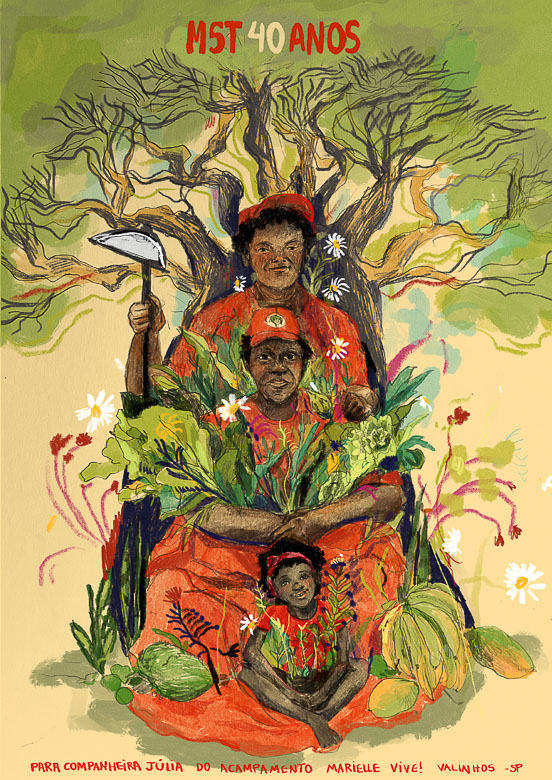
Notes
1MST, ‘Nossa Historia’.
2The first National Agrarian Reform Plan was announced in 1985, after fall of the business-military dictatorship, but was never implemented.
3Jakobskind, ‘Stedile faz palestra’.
4MST, ‘Nossa produção’.
5As the MST explains in its journal ITERRA Notebooks, the movement’s pedagogy ‘understands that social subjects are shaped in people’s movements and that it is in these spaces that fundamental processes of human development and education take place. In other words, social subjects are molded and learn within the dynamics of organised social struggle, which is the material basis of the MST’s educational processes. The movement also understands that the social struggle that molds subjects produces and reproduces society and people’s lives as a revolutionary praxis’. ITERRA, Método Pedagógico.
6Before the arrival of the Portuguese, the land that was to become Brazil was home to an estimated five million people who lived in village communities, with communal control over hunting, fishing, gathering, and horticulture. See Maestri, ‘A Aldeia ausente’.
7Translator’s note: Quilombos, occasionally translated as ‘maroon communities’ were rural settlements founded by people who escaped from slavery that became sites of resistance and created their own form of organisation. The communities where their descendants live, known as quilombolas, have special land and social rights and benefits similar to those of indigenous reservations.
8DIEESE, Estatísticas do meio rural 2010–2011, 30.
9For a more detailed analysis of the agrarian question in Brazil, see our dossier no. 27, Popular Agrarian Reform and IBGE, Censo Agropecuário.
10Spadotto and Gomes, ‘Agrotoxicos no Brasil’.
11Martins, A Questão Agrária no Brasil, 302.
12MST, Programa de Reforma Agrária Popular.
13FPA, ‘Todos os membros’.
14CPT, Conflitos no campo Brasil 2022, 5.
15MST, Programa de Reforma Agrária Popular, 13–14, our translation.
16Castro, ‘MST completa 37 anos’.
17Translator’s note: A fundamental organisational unit within the MST, base groups are small, grassroots collectives of landless families or individuals that serve as the primary space for political education, decision-making, and the coordination of activities. The structure and function of base groups reflect the movement’s commitment to participatory democracy, grassroots organising, and the creation of an alternative, more equitable society.
18MST, ‘With Another Donation’.
19MST, ‘Educação’.
20To learn more about the role of intellectuals in our work, see: Tricontinental: Institute for Social Research, The New Intellectual, dossier no. 14, 11 February 2019, https://thetricontinental.org/the-new-intellectual/.
21Sudré, ‘Conheça a escola nacional’.
22Pine, ‘Empressa controlam’.
23Tricontinental: Institute for Social Research, Big Tech.
24Tricontinental: Institute for Social Research, ‘Complexo da soja’.TOP
Bibliography
Mariana Castro, ‘MST completa 37 anos e mostra a força da agricultura familiar durante a pandemia’ [The MST Turns 37 and Shows the Strength of Family Farming during the Pandemic], MST, 22 January 2021, https://mst.org.br/2021/01/22/mst-completa-37-anos-e-mostra-a-forca-da-agricultura-familiar-durante-a-pandemia/.
Comissão Pastoral da Terra [Pastoral Land Commission]. Conflitos no campo Brasil 2022 [Conflicts in Brazil’s Countryside 2022]. Goiânia: CPT Nacional, 2023. https://www.cptnacional.org.br/downlods/download/41-conflitos-no-campo-brasil-publicacao/14302-livro-2022-v21-web.
Departamento Intersindical de Estatística e Estudos Socioeconômicos (DIEESE) [Inter-Union Department of Statistics and Socioeconomic Studies]. Estatísticas do meio rural 2010–2011 [Rural Statistics 2010–2011]. 4th edition. Brasília: Departamento Intersindical de Estatística e Estudos Socioeconômicos, Núcleo de Estudos Agrários, and Desenvolvimento Rural / Ministério do Desenvolvimento Agrário, 2011. https://www.dieese.org.br/anuario/2011/anuarioRural10-11.html.
Frente Parlamentar da Agropecuária (FPA) [Parliamentary Agricultural Front]. ‘Todos os membros’ [All Members]. 25 July 2023. https://fpagropecuaria.org.br/todos-os-membros.
Greco Martins, Adalberto Floriano. A produção ecológica de arroz e a reforma agrária popular [Ecological Rice Production and Popular Agrarian Reform]. São Paulo: Expressão Popular, 2019.
Greco Martins, Adalberto Floriano. A Questão Agrária no Brasil: da colônia ao governo Bolsonaro [The Agrarian Question in Brazil: From the Colony to the Bolsonaro Government]. Volume 10. São Paulo: Expressão Popular, 2022.
Instituto Técnico de Capacitação e Pesquisa da Reforma Agrária (ITERRA). Cadernos do Iterra no. 9 – Método Pedagógico [ITERRA Notebooks no. 9: Pedagogical Method]. Veranópolis: ITERRA, 2004. https://www.scribd.com/document/622870231/ITERRA-Nº-09-Metodo-Pedagogico-2004.
Instituto Brasileiro de Geografia e Estatística (IBGE) [Brazilian Institute of Geography and Statistics]. Censo Agropecuário, Florestal e Aquícola 2017 [Agricultural, Forestry, and Aquaculture Census 2017]. Accessed 29 March 2024. https://censoagro2017.ibge.gov.br.
Jakobskind, Mário Augusto. ‘Stedile faz palestra na escola superior de guerra’ [Stedile Gives a Lecture at War College]. 19 July 2006. https://mst.org.br/2006/07/19/stedile-faz-palestra-na-escola-superior-de-guerra/.
Maestri, Mario. ‘A Aldeia ausente: índios, caboclos, cativos, moradores e imigrantes na formação da classe camponesa brasileira’ [The Absent Village: Indians, Caboclos, Captives, Residents, and Immigrants in the Formation of the Brazilian Peasant Class]. In A questão agrária no Brasil, volume 2 – O debate na esquerda 1960–1980 [The Agrarian Question in Brazil, Volume 2: The Debate on the Left 1960–1980]. Organised by João Pedro Stedile. São Paulo: Expressão Popular, 2005. 217–276.
Movimento dos Trabalhadores Rurais Sem Terra (MST) [Landless Rural Workers’ Movement]. Normas gerais e Princípios Organizativos [General Rules and Organisational Principles]. Training Notebook no. 40, 2016. https://www.scribd.com/document/622870064/Caderno-nº-40-Normas-gerais-e-principios.
MST. ‘With Another Donation, the Landless Workers Movement (MST) Sends Out another 11 Tons of Food to Families in Gaza’. 8 December 2023. https://mst.org.br/2023/12/08/with-another-donation-the-landless-workers-movement-mst-sends-out-another-11-tons-of-food-to-families-in-gaza/.
MST. Programa de Reforma Agrária Popular [Popular Agrarian Reform Programme]. 2024. Unpublished.
MST. ‘O MST: Nossa historia: 97–99’ [The MST: Our History: 97–99]. Accessed 27 February 2024. https://mst.org.br/nossa-historia/97-99/.
MST. ‘O MST: Nossa produção’ [The MST: Our Production]. Accessed 27 February 2024. https://mst.org.br/nossa-producao/.
MST. ‘Educação MST’ [MST Education]. Accessed 27 February 2024. https://mst.org.br/educacao/.
Pina, Rute. ‘Só 87 empresas controlam a cadeia produtiva do agronegócio’ [Just 87 Companies Control the Agribusiness Supply Chain]. Brasil de Fato, 4 September 2018. https://www.brasildefato.com.br/2018/09/04/so-87-empresas-controlam-a-cadeia-produtiva-do-agronegocio/.
Salgado, Sebastião. Terra: Struggle of the Landless. London: Phaidon Press, 1997.
Spadotto, Cláudio Aparecido and Marco Antonio Ferreira Gomes. ‘Agrotóxicos no Brasil’ [Agrotoxins in Brazil]. Embrapa, 22 December 2021. https://www.embrapa.br/agencia-de-informacao-tecnologica/tematicas/agricultura-e-meio-ambiente/qualidade/dinamica/agrotoxicos-no-brasil#:~:text=Expresso%20em%20quantidade%20de%20ingrediente,agr%C3%ADcola%20aumentou%2078%25%20nesse%20per%C3%ADodo.
Sudré, Lu. ‘Conheça a Escola Nacional Florestan Fernandes, há 15 anos formando militantes’ [Get to Know the Florestan Fernandes National School, Which Has Been Training Militants for 15 Years]. MST, 24 January 2020. https://mst.org.br/2020/01/24/conheca-a-escola-nacional-florestan-fernandes-ha-15-anos-formando-militantes/.
Tricontinental: Institute for Social Research. ‘Complexo da Soja: Análise dos dados nacionais e internacionais’ [The Soy Complex: Analysing National and International Data]. 13 November 2019. https://thetricontinental.org/pt-pt/brasil/complexo-da-soja-analise-dos-dados-nacionais-e-internacionais/.
Tricontinental: Institute for Social Research. Popular Agrarian Reform and the Struggle for Land in Brazil. Dossier no. 27, 6 April 2020. https://thetricontinental.org/dossier-27-land/.
Tricontinental: Institute for Social Research. Big Tech and the Current Challenges Facing the Class Struggle. Dossier no. 46, 1 November 2021. https://thetricontinental.org/dossier-46-big-tech/.
Tricontinental: Institute for Social Research. Gramsci in the Midst of Brazil’s Landless Workers’ Movement (MST): An Interview with ‘Militante’ Neuri Rossetto. Dossier no. 54, 19 July 2022. https://thetricontinental.org/dossier-54-gramsci-mst-rossetto/.

